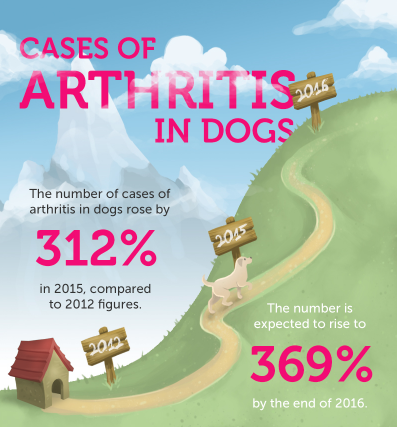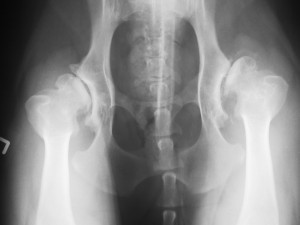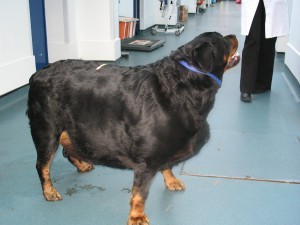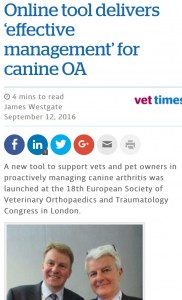
According to recent research, the number of dogs diagnosed as suffering with arthritis tripled between 2012 and 2015. Pet insurer Animal Friends analysed 20,000 pet records and found that cases of arthritis in dogs rose by 312% during the period. The number of dogs with the condition is expected to rise even further to around 369% by the end of this year.
What is canine osteoarthritis?
Osteoarthritis is defined as the progressive and permanent long-term deterioration of the cartilage and other structures making up joints. Arthritis is the medical term for inflammation of the joints, while osteoarthritis is the term referring to a form of chronic joint inflammation caused by deterioration of joint cartilage and other joint components.
 What causes the condition?
What causes the condition?
Inside a dog’s joints, bone surfaces are normally covered with a thin layer of very smooth cartilage, lubricated with a small amount of joint fluid that allows the two surfaces to glide freely and the joint to move smoothly. In dogs with arthritis, cartilage within the joint undergoes change or damage, becoming less smooth and resulting in the bone surfaces rubbing together. This causes discomfort to your dog, as well as further damage to cartilage. A painful inflammatory process is started which begins to involve all of the other structures of the joint resulting in more pain, swelling and stiffness of the affected joint. As the arthritis progresses with time the changes become more obvious.
What are the signs?
Signs will vary depending on the age of the dog, the joints that are affected, and also the severity of the condition. Most signs are the result of pain. Your dog is likely to alter its gait, putting more weight on the unaffected limbs and appear rigid, as we would if we had a bad joint.
There may be muscle atrophy (reduction in the size of the muscle) in the affected limb because the dog is using it less, or at least putting less weight on it and an associated weakness due to decreased use of the limb.
Your dog may struggle to get up after lying down and appear stiff and find it difficult to get up and down stairs or to jump in and out of the car. Depending on the amount and type of pain your dog is in, he may go off food and his behaviour may change in that he wants to go off by himself more, particularly to warm and soft places to sleep. Other changes may include alteration in other normal habits; no interest in exercise; avoiding certain activities and human contact and even showing aggression to other dogs or humans.

How is osteoarthritis treated?
OA is a progressive disease, so your dog’s condition will get worse over time. It is typified by chronic pain which is difficult from normal acute pain and much harder to control or eliminate. There are however a number of medical and surgical treatments available to control chronic pain, slow the progression of the disease and improve the quality of life for your dog. The most important objective is to manage and control pain
Medical Management
Most commonly arthritic pain is managed by using aspirin type drugs called non-steroidal inflammatory agents. They are very effective in controlling the type of pain we see in arthritis and are easy to use.
Diet
Most owners don’t realise how important allowing their pet to become overweight is in the appearance and progress of the disease. Overweight dogs show signs early and are much harder to manage, therefore a very important management aim is to get affected pets to their normal bodyweight.
Nutraceuticals and dietary supplements
Joint supplements are used very commonly in the management of osteoarthritis and yet there is little firm evidence that they have a beneficial effect. They are used as safe or natural alternatives to other pain relieving medications or procedures despite the fact that there is scant evidence that they relieve pain. They may have a role in helping joint repair but should always be accompanied by analgesic management if the pet is in pain.
Natural treatments
There is little firm evidence for the use of many so-called natural remedies in osteoarthritis. Many of these are used out of frustration with standard therapy. There is an over-reliance in this type of approach to chronic diseases like arthritis which is essentially a simple painful disease.
Newer Therapies
There is a rise in therapies that can be used to manage arthritis. Many of these are new and still being fully investigated but can be useful in particular cases. These include the control of pain by acupuncture, using laser therapy and injecting various products including stem cells into joints. Surgical management implanting artificial joints is also becoming a more commonly used option in certain joints like the hip.
Exercise
Exercise for a pet is essential for normal well-being and it is important in animals suffering from arthritis to maintain normal muscle mass and joint function. However it must be controlled at times to avoid damaging and affected joint or causing pain.
Physiotherapy
Physiotherapy techniques can help both to relieve pain and maintain mobile joints. They can target certain areas and are a more specific method of achieving the results that we want from exercise while avoiding the risks of causing more joint damage.
 Frustration with Treatment
Frustration with Treatment
Generally dogs with osteoarthritis are managed for an insufficient time period to properly manage the chronic pain that typifies the disease. Treatment is stopped too early. This means that they do not get the full benefits of management and continually show the same problems becoming more immobile and less able to lead a normal life. Arthritis is a lifestyle problem and requires more attention than giving a simple pill.
How do I combine the right types of treatmentfor my dog?
 Aim-OA. Sys is a revolutionary new app which focuses on six areas for managing the condition and provides a bespoke treatment plan for each individual patient. Aim-OA.Sys consists of a series of questions for the pet owner that can be completed in the practice waiting room on an iPad or on a web enabled device, and questions for the vet based on their clinical examination. The information is then analysed according to the latest centralised algorithms and a unique report on the condition, clinical needs, planning and long term management requirements is produced for the patient.
Aim-OA. Sys is a revolutionary new app which focuses on six areas for managing the condition and provides a bespoke treatment plan for each individual patient. Aim-OA.Sys consists of a series of questions for the pet owner that can be completed in the practice waiting room on an iPad or on a web enabled device, and questions for the vet based on their clinical examination. The information is then analysed according to the latest centralised algorithms and a unique report on the condition, clinical needs, planning and long term management requirements is produced for the patient.
Long term monitoring and support is provided via Aim OA alerts which indicate good/poor success and provide support information to help the practitioner customise plans for each patient on an on going basis. The evidence-based system was developed by the world’s leading OA experts and launched in London in September 2016.
 The app is now available via veterinary practices.
The app is now available via veterinary practices.
To find out more, please visit www.aim-oa.com